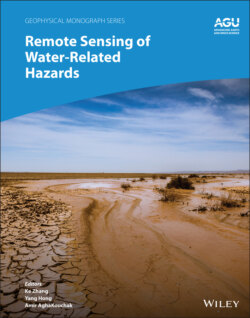Читать книгу Remote Sensing of Water-Related Hazards - Группа авторов - Страница 32
2.4.2. Regional and Seasonal Characteristics
ОглавлениеIn this section, two types of diagrams, i.e., Taylor diagrams and performance diagrams, are used to assess the seasonal and regional bias features of various products. Three metrics (CC, standard deviation, and centered root mean square difference [RMSD]) are synthesized in the Taylor diagram. The distance between points and the “observation” point is inversely proportional to the accuracy (Figure 2.5). Four metrics, i.e., POD; CSI; success ratio, which equals one minus FAR; and bias score, which equals POD divided by success ratio, are integrated into the performance diagrams. The distance between points and the top right corner is inversely proportional to the accuracy (Figure 2.6).
Figure 2.6 Performance diagrams on the daily scale from 2000 to 2018 for different seasons and regions, including whole China, TP, XJ, and NE. Blue lines represent bias scores. Green lines represent CSI.
Source: Based on Tang et al. (2020).
GSMaP shows the best performance except during winter in TP, XJ, and NE, as shown in Figure 2.5. IMERG is relatively weak in estimating precipitation under cold climate, e.g., during winter in China and XJ and during spring, autumn, and winter in NE. Summer is the only season in NE when the temperature is relatively high and precipitation is abundant, contributing to the better performance of IMERG. IMERG performs better than other products during winter in TP, which is unexpected, calling for further investigation. Although SM2RAIN is among the worst products in the whole China, TP, and NE areas, its accuracy is relatively higher in XJ because soil moisture is more sensitive to precipitation in arid regions and seldom saturated due to the scarcity of extreme precipitation. Reanalysis products including ERA5, ERA‐Interim, and MERRA2 perform better during winter, except in TP where large standard deviation and RMSD degrade their overall performance, although they acquire the highest CC. In NE, reanalysis products can also capture precipitation well, except during summer when precipitation is notably larger than other seasons. This is because reanalysis products are better at estimating stratiform precipitation than convective precipitation.
As shown in performance diagrams (Figure 2.6), GSMaP is the best in detecting precipitation occurrence in all seasons and subregions. Points representing the three reanalysis products are always clustered together and only second to GSMaP in most cases, indicating that their occurrence detection mechanism is excellent but probably consistent. IMERG performs reasonably well in spring, summer, and autumn but notably worse in winter, as also shown in Taylor diagrams. Points of IMERG_cal and IMERG_uncal are always overlapped, meaning that the monthly‐scale gauge adjustment has little impact on occurrence detection on the daily scale.
PCDR and CHIRPS are better than other satellite products at detecting precipitation during winter in TP, XJ, and NE, showing the potential of infrared data in the cold season. It is found that CMORPH is the worst during winter, particularly in XJ and NE, where it cannot capture precipitation events correctly according to the extremely small POD values and large FAR values. CMORPH relies on passive microwave data to acquire seamless precipitation estimates, and infrared data are only used to calculated cloud motion vectors. In contrast, microwave‐infrared combined products such as IMERG utilize infrared data to fill the gap between passive microwave sensors and replace passive microwave estimates over snowy and icy surface types. The limitation of passive microwave data leads to the degraded quality of CMORPH during winter.
